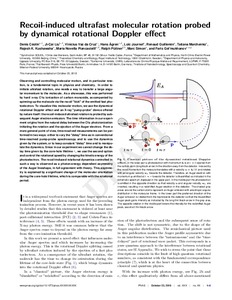Показать сокращенную информацию
Recoil-induced ultrafast molecular rotation probed by dynamical rotational Doppler effect
| Автор | Denis, Ceolina | |
| Автор | Ji-Cai, Liu | |
| Автор | Vinicius Vaz, Da Cruz | |
| Автор | Hans, Agren | |
| Автор | Loic, Journele | |
| Автор | Renaud, Guillemin | |
| Автор | Tatiana, Marchenko | |
| Автор | Rajesh K. Kushawaha | |
| Автор | Maria, Novella Piancastelli | |
| Автор | Ralph, Puttnerf | |
| Автор | Marc, Simon | |
| Автор | Faris Gel’mukhanov | |
| Дата внесения | 2020-01-20T07:53:25Z | |
| Дата, когда ресурс стал доступен | 2020-01-20T07:53:25Z | |
| Дата публикации | 2019-03 | |
| Библиографическое описание | Denis, Ceolina. Recoil-induced ultrafast molecular rotation probed by dynamical rotational Doppler effect [Текст] / Ceolina Denis, Liu Ji-Cai, Da Cruz Vinicius Vaz, Agren Hans, Journele Loic, Guillemin Renaud, Marchenko Tatiana, Rajesh K. Kushawaha, Novella Piancastelli Maria, Puttnerf Ralph, Simon Marc, Faris Gel’mukhanov // Proceedings of the National Academy of Sciences of the United States of America. — 2019. — Т. 116 (№ 11). — С. 4877-4882 | |
| ISSN | 00278424 | |
| URI (для ссылок/цитирований) | https://www.pnas.org/content/116/11/4877 | |
| URI (для ссылок/цитирований) | https://elib.sfu-kras.ru/handle/2311/128955 | |
| Описание | Текст статьи не публикуется в открытом доступе в соответствии с политикой журнала. | |
| Аннотация | Observing and controlling molecular motion and in particular rotation are fundamental topics in physics and chemistry. To initiate ultrafast rotation, one needs a way to transfer a large angular momentum to the molecule. As a showcase, this was performed by hard X-ray C1s ionization of carbon monoxide accompanied by spinning up the molecule via the recoil “kick” of the emitted fast photoelectron. To visualize this molecular motion, we use the dynamical rotational Doppler effect and an X-ray “pump-probe” device offered by nature itself: the recoil-induced ultrafast rotation is probed by subsequent Auger electron emission. The time information in our experiment originates from the natural delay between the C1s photoionization initiating the rotation and the ejection of the Auger electron. From a more general point of view, time-resolved measurements can be performed in two ways: either to vary the “delay” time as in conventional time-resolved pump-probe spectroscopy and use the dynamics given by the system, or to keep constant delay time and manipulate the dynamics. Since in our experiment we cannot change the delay time given by the core-hole lifetime τ, we use the second option and control the rotational speed by changing the kinetic energy of the photoelectron. The recoil-induced rotational dynamics controlled in such a way is observed as a photon energy-dependent asymmetry of the Auger line shape, in full agreement with theory. This asymmetry is explained by a significant change of the molecular orientation during the core-hole lifetime, which is comparable with the rotational period. | |
| Тема | X-ray ionization | |
| Тема | carbon monooxide | |
| Тема | rotational Doppler effect | |
| Тема | recoil-induced | |
| Тема | photoionization | |
| Тема | core-hole lifetime | |
| Название | Recoil-induced ultrafast molecular rotation probed by dynamical rotational Doppler effect | |
| Тип | Journal Article | |
| Тип | Journal Article Postprint | |
| Страницы | 4877-4882 | |
| ГРНТИ | 29.29 | |
| Дата обновления | 2020-01-20T07:53:25Z | |
| DOI | 10.1073/pnas.1807812116 | |
| Подразделение | Научно-исследовательская часть | |
| Журнал | Proceedings of the National Academy of Sciences of the United States of America | |
| Квартиль журнала в Scopus | Q1 | |
| Квартиль журнала в Web of Science | Q1 |

